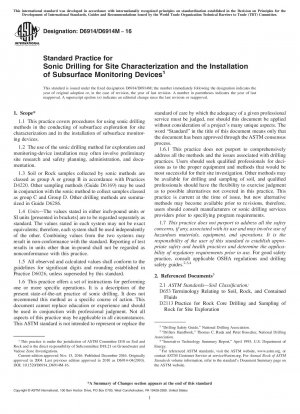ASTM D6914/D6914M-16
Standard Practice for Sonic Drilling for Site Characterization and the Installation of Subsurface Monitoring Devices
- Standard No.
- ASTM D6914/D6914M-16
- Release Date
- 2016
- Published By
- American Society for Testing and Materials (ASTM)
- Status
- Replace By
- ASTM D6914/D6914M-16(2024)
- Latest
- ASTM D6914/D6914M-16(2024)
- Scope
-
5.1 Sonic drilling is a rapid, primarily dry drilling method (see 5.2), used both in geotechnical applications to avoid hydraulic fracturing, and in environmental site exploration. Geotechnical applications include exploration for tunnels, underground excavations, and installation of instrumentation or structural elements. Sonic drilling methods are used in rocky soils with large diameter casing to obtain continuous samples in materials that are difficult to sample using other methods. It is well suited for projects of a production-orientated nature with a drilling rate faster than most all other drilling methods (Guide D6286). Sonic drilling is used for environmental explorations because sonic drilling offers the benefit of significantly reduced drill cuttings, a major cost element, and reduced drill fluid use and production. Sonic drilling offers rapid formation penetration thereby increasing production. It can reduce fieldwork time generating overall project cost reductions. The continuous core sample recovered provides a representative lithological column for review and analysis. Sonic drilling readily lends itself to environmental instrumentation installation and to in-situ testing. The advantage of a clean cased hole without the use of drilling fluids provides for increased efficiency in instrumentation installation. The ability to cause vibration to the casing string eliminates the complication of monitoring well backfill bridging common to other drilling methods and reduces the risk of casing lockup allowing for easy casing withdrawal during grouting. The clean borehole reduces well development time. Pumping tests can be performed as needed prior to well screen placement to allow for proper screen location. The sonic method is readily utilized in multiple cased well applications which are required to prevent aquifer cross contamination. The installation of inclinometers, vibrating wire piezometers, settlement gauges, and the like can be accomplished efficiently with the sonic method.
5.2 The cutting action, as the sonic drilling bit passes through the formation, may cause disturbance to the soil structure along the borehole wall. The vibratory action of directing the sample into the sample barrel and then vibrating it back out can cause distortion of the specimen. Core samples can be hydraulically extracted from the sample barrel to reduce distortion. The use of split barrels, with or without liners, may improve the sample condition but may not completely remove the vibratory effect. When penetrating rock formations, the vibration may create mechanical fractures that can affect structural analysis for permeability and thereby not reflect the true in-situ condition. Sonic drilling in rock will require the use of air or fluid to remove drill cuttings from the face of the bit, as they generally cannot be forced into the formation. Samples collected by the dry sonic coring method from dense, dry, consolidated or cemented formations may be subjected to drilling induced heat, which could be a concern if core sampling for volatile organic compounds using Practice D6640. Heat is generated in these dry formations by the impact of the bit on the formation and the friction created when the core barrel is forced into the formation. The sampling barrel is advanced without drilling fluid whenever possible. Therefore, in very dense formations, drilling fluids may have to be used to remove drill cuttings from the bit face and to control drilling generated h......
ASTM D6914/D6914M-16 history
- 2024 ASTM D6914/D6914M-16(2024) Standard Practice for Sonic Drilling for Site Characterization and the Installation of Subsurface Monitoring Devices
- 2016 ASTM D6914/D6914M-16 Standard Practice for Sonic Drilling for Site Characterization and the Installation of Subsurface Monitoring Devices
- 2004 ASTM D6914-04(2010) Standard Practice for Sonic Drilling for Site Characterization and the Installation of Subsurface Monitoring Devices
- 2004 ASTM D6914-04e1 Standard Practice for Sonic Drilling for Site Characterization and the Installation of Subsurface Monitoring Devices
- 2004 ASTM D6914-04 Standard Practice for Sonic Drilling for Site Characterization and the Installation of Subsurface Monitoring Devices

Copyright ©2024 All Rights Reserved